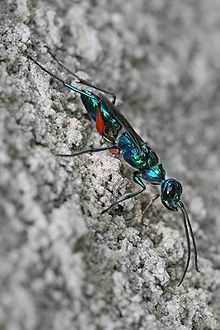Entomophagous parasite
Entomophagous parasites (coined from Greek entomon "insect" and Gk. -phagos "eater of") are insects that are parasitic on other insects. Nearly all insects are attacked by one or more insect parasites. This parasitic mode of life is most often confined to the larvae with the adults usually leading free lives. The vast majority of Hymenopterous insect parasites are usually restricted to specific hosts, such as Embidobia (parasitic on Embioptera), Platygaster and Polygnotus (on Cecidomyiidae), Scelio (on locust eggs) and Aphidius (on Aphids). Often, species that are hyperparasites are less host-specific.
Parasitoids

Species whose feeding on the host leads to the certain death of the host, typically before the host reached reproduction, are termed parasitoids. In some cases, the larvae feed externally on paralyzed hosts, typically provided by the parent in special brood chambers; this life history is common among Scoliidae, Thynnidae, Mutillidae, and other predatory wasps. Others seek the eggs, larvae or pupae of various insects and deposit their eggs within them. The larvae develop on these stages of the host, killing it in the end. The parasitoid mode of life is common in Hymenoptera, especially within the Ichneumonoidea, Chalcidoidea and Proctotrupoidea and in Diptera (Tachinidae).
Strepsiptera differ in that the adult males live free lives with the females remaining as endoparasites, in a larval like state, feeding on the host in many Neuroptera and in the Epipyropidae among Lepidoptera.
Superparasitism
Superparasitism is a form of parasitism in which the host (typically an insect larva such as a caterpillar), is attacked more than once by a single species of parasitoid.
Multiparasitism
Multiparasitism, also called multiple parasitism, on the other hand, occurs when the host has been parasitized by more than one species.[1]
Hyperparasitism
In hyperparasitism, a parasite is itself attacked by another parasite. Species of the chalcid Perilampus are often parasitic on the ichneumonoid genera Microgaster and Apanteles, which are parasites of caterpillars of Lepidoptera. The hyperparasites are usually far less restricted in their selection of host than the parasites. Many hyperparasites are ectoparasites. The effect of attack by the parasite is usually slow death of the host, though very rarely it leads to castration of the host (as in parasitism by Strepsiptera).
Social parasites
The term social parasitism is given to the relation of the guests in the nests of various social insects. In the case of certain species of ants this takes a special form called slavery. The slave-driving ants regularly capture the pupae from the nest of other species of ants, carry them to their own nest and compel the workers emerging from the pupae to breed their own brood. The ant Anergates indeed rears no workers of its own, but invades the nests of Tetramorium and carries off the brood to its own nests. They are incapable of feeding for themselves but have to be fed by the slaves. Robbing is also a kind of social parasitism called cleptoparasitism. The so-called bee lice invade the nests of bees and devour the store of food in them. Brood parasitism, met within the Chrysididae, Mutillidae, robber bees, parasitic bees and in certain Meloid beetles, refers to the smuggling of the eggs into the brood nest of another insect.
References
- Chapman, R.N, 1931. Animal Ecology, London and New York
- Cockerell, T.D.A. 1891, The Use of Ants to Aphids, and Coccids, Nature, 44: 608;
- Comstock, J.H, 1886. Relation to Ants and Aphids, Amer .Nat., 21:382.
- Folsom,J. W. 1934. Entomology with Special Reference to its Ecological Aspects, Philadelphia: Blackiston and Sons, p. 605
- Shaffie,S.A., A. Alam and M.M. Agrawal, 1955.Taxonomic Survey of Eneyrtid Parasites in India, Aligarh Mus. Univ. Pub. Zool) 9.10; p. 238.
- Mani. M.S. 1968,General Entomology, Oxford and IBS Publishing Co. (New Delhi Bombay Calcutta) 228-229
- Clausen, Curtis P.,1940, Entomophagous Insects, McGraw-Hill, New York